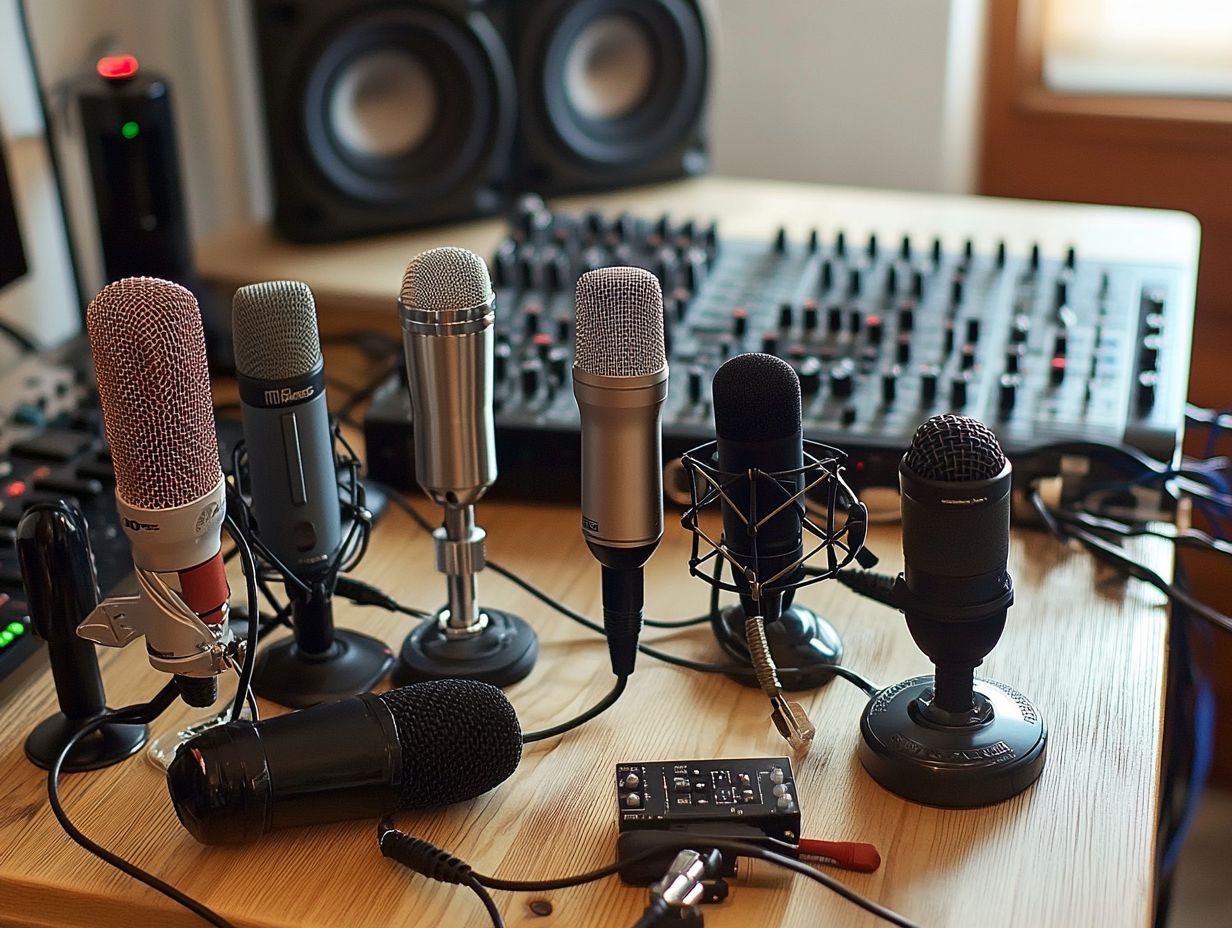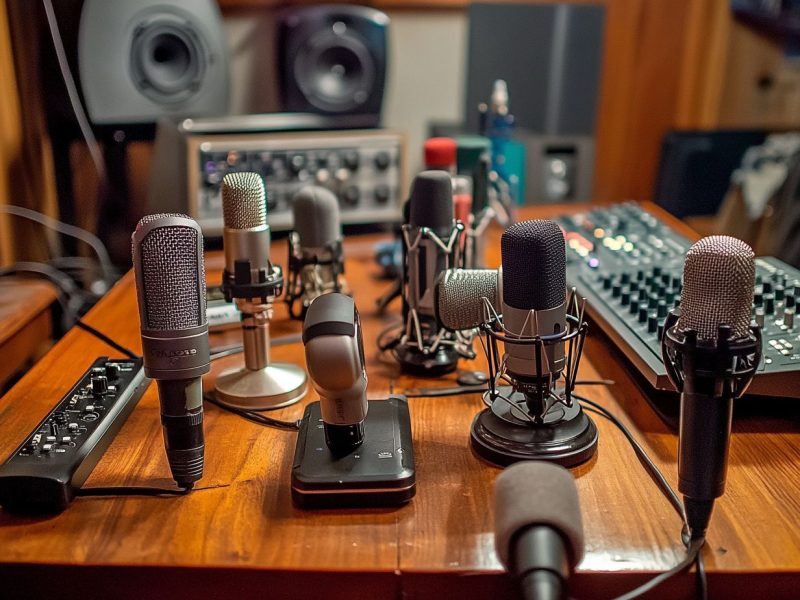Selecting the appropriate microphone is crucial for achieving high-quality sound in a home studio setting. Given the wide array of options available, including condenser and dynamic microphones as well as USB and XLR models, it can be challenging to determine which choice best aligns with your specific requirements.
This guide provides an overview of the different types of microphones, highlights top recommendations, and offers advice on how to set them up for optimal performance. It also addresses common pitfalls to avoid, ensuring that you maximize your recording experience.
What to Consider When Choosing a Microphone

When selecting the most suitable microphone for a home studio, it is imperative to consider several factors, including the types of microphones available—such as condenser, dynamic, and USB microphones—as well as their sound quality, frequency response, and sensitivity. These considerations are essential to ensure optimal audio recording tailored to specific needs, whether for vocal performances, instrument recordings, or podcasting.
Sound isolation is a critical aspect of capturing clear audio, as it helps to minimize unwanted background noise that may compromise recording quality. For example, dynamic microphones are frequently preferred in live environments due to their durability and effective noise rejection capabilities.
In contrast, condenser microphones are adept at capturing subtle nuances, making them particularly suitable for voice-over work and studio recordings, as they offer exceptional clarity.
Additionally, assessing features such as noise cancellation can further enhance audio quality by filtering out ambient sounds. Ultimately, selecting the appropriate microphone type based on its intended applications will significantly improve the overall sound production in any home studio setting.
Types of Microphones for Home Studios
Understanding the different types of microphones available for home studios is essential for attaining optimal sound quality in audio recording projects.
The primary categories include:
- Condenser microphones, which are preferred for their sensitivity and wide frequency response;
- Dynamic microphones, recognized for their durability;
- USB microphones, which provide portability and ease of use, making them particularly suitable for budget-conscious setups.
Condenser vs Dynamic Microphones
Condenser microphones and dynamic microphones each present distinct advantages and disadvantages that can significantly influence the sound quality of recordings. Condenser microphones are characterized by their greater sensitivity and wider frequency response, rendering them ideal for capturing vocals and instruments with high detail. In contrast, dynamic microphones are renowned for their durability and are often favored for live settings and louder sound sources.
In studio environments, the clarity and precision of a condenser microphone can be particularly advantageous, especially during vocal performances and intricate acoustic instrument recordings. These settings benefit from the condenser’s ability to capture subtle nuances in both voice and sound.
Conversely, dynamic microphones are typically the preferred choice for live performances and situations with high sound pressure levels, such as rock concerts or broadcasting, where durability and feedback rejection are of utmost importance.
In the realm of podcasting, while some individuals may favor condenser microphones for their rich sound profiles, dynamic microphones are capable of effectively handling vocal sibilance and ensuring clarity in noisy environments, thus making them versatile options for various audio production needs.
USB vs XLR Microphones
The decision between USB microphones and XLR microphones is primarily influenced by an individual’s recording requirements and setup. USB microphones are highly regarded for their ease of use and portability, making them ideal for podcasting or home video production.
In contrast, XLR microphones necessitate the use of an audio interface but provide superior sound quality and flexibility, particularly in a professional home studio environment.
For novices or those requiring a quick setup, USB microphones typically connect directly to a computer or laptop, thereby eliminating the need for additional equipment and facilitating a seamless recording experience.
Conversely, experienced users often gravitate towards XLR microphones due to their exceptional audio fidelity and versatility. These microphones can be integrated into complex audio systems, yielding a richer sound, which is particularly valuable in music production or live performance settings.
While USB microphones are generally self-contained and require minimal configuration, XLR microphones offer the potential for expansion with various preamps and mixers, thereby allowing for enhanced control over sound quality and effects.
Ultimately, the appropriate choice is contingent upon the user’s objectives and level of technical proficiency.
Top Microphones for Home Studios

Identifying the most suitable microphones for home studios necessitates a thorough examination of various models that offer exceptional sound quality, durability, and user experience.
The selection ranges from high-end microphones that deliver professional audio fidelity to budget-friendly options that provide excellent value for beginners. The best choices encompass a variety of brands and types, ensuring that there is an appropriate microphone available for any recording project.
Features and Benefits of Each Option
Each top microphone option presents unique features tailored to specific recording requirements, enhancing sound quality and overall performance. Key benefits may include advanced microphone accessories that improve sound capture, versatile recording techniques suitable for mixing and mastering, and user-friendly designs that enhance the recording experience.
For example, certain models incorporate advanced noise-cancellation technology, which significantly mitigates background noise, thereby facilitating clearer vocal recordings. Additionally, some microphones are constructed with durability in mind, making them suitable for both studio environments and portable applications, thus increasing their longevity and reliability.
When comparing sound quality, it is evident that specific microphones excel in capturing high frequencies, making them particularly well-suited for intricate musical instruments, while others provide a warm tone that is ideal for vocal recordings. This versatility ensures that, regardless of the recording scenario, there is a microphone available that can enhance the overall audio production experience.
How to Set Up and Use a Microphone in a Home Studio
Establishing and utilizing a microphone in a home studio necessitates meticulous attention to detail to enhance sound quality and facilitate a seamless recording experience.
This process involves several critical steps, including:
- Creating an optimal studio setup
- Soundproofing the recording environment
- Ensuring proper microphone placement
- Connecting the microphone through an audio interface or phantom power supply
Each of these elements is essential for achieving superior audio fidelity.
Tips and Techniques for Optimal Sound Quality
Achieving optimal sound quality requires the implementation of specific tips and techniques that enhance the recording process, ensuring clarity and depth in audio captures. Key factors include strategic microphone placement, effective recording techniques, and the use of audio editing tools to refine vocal effects and the overall mix.
To further enhance sound quality, it is essential to adopt precise microphone placement strategies that can significantly influence the emotional resonance of the recording. Proper positioning of the microphone, at an appropriate distance, can minimize background noise while emphasizing vocal clarity.
Incorporating pop filters is an effective measure to reduce plosive sounds, resulting in a cleaner final product. Additionally, adjusting recording settings—such as gain levels and optimizing room acoustics—creates an environment that is conducive to exceptional sound capture.
Following the recording phase, audio editing techniques, including equalization and compression, can effectively polish vocals, ensuring they blend harmoniously within the mix and enhance overall sound clarity.
Common Mistakes to Avoid When Using Home Studio Microphones

Avoiding common mistakes when utilizing home studio microphones is essential for achieving professional-quality recordings and optimizing sound quality.
Frequent pitfalls include improper microphone placement, neglecting sound isolation techniques, and failing to account for the recording environment’s influence on the noise floor. Each of these factors can significantly detract from the clarity and fidelity of audio captures.
Troubleshooting and Solutions
Troubleshooting audio quality issues can present significant challenges; however, the implementation of targeted solutions can streamline the process and enhance recording outcomes.
Common difficulties may include unwanted feedback, subpar sound quality, and various technical issues, all of which can typically be addressed through thorough microphone testing and adjustments in the recording setup.
By carefully examining the placement and orientation of the microphone, individuals can substantially improve sound capture. It is crucial to minimize potential interference from background noise during the recording session, which can be accomplished through the application of soundproofing techniques or strategic acoustic treatment.
Exploring different microphone types and settings can assist in determining the optimal conditions for various audio sources. Regularly conducting tests, such as reviewing recorded samples, facilitates the identification of specific audio anomalies, allowing for timely corrections.
By employing these methods, the overall quality of recordings can be significantly enhanced, resulting in professional-grade audio outputs.
Frequently Asked Questions
What are the best microphones for a home studio?
The best microphones for a home studio will depend on the type of recording you want to do. Options include dynamic, condenser, and ribbon microphones. Some popular choices for home studios include the Shure SM58, Audio-Technica AT2020, and Rode NT1-A.
What are the main differences between dynamic and condenser microphones?

Dynamic microphones are better for loud and dynamic sounds, while condenser microphones are better for capturing detail and nuance in quieter sounds. Dynamic microphones are also more durable and have a more limited frequency range compared to condenser microphones.
What factors should I consider when choosing a microphone for my home studio?
Key factors to consider when choosing a microphone for your home studio include the type of recording you’ll be doing, your budget, the microphone’s frequency response and polar pattern, and the quality of the microphone’s build and components.
Do I need a pop filter for my microphone?
A pop filter can help reduce plosives and other unwanted sounds from your vocal recordings. However, it is not always necessary, especially if you have a good microphone technique. If you do choose to use a pop filter, make sure it is placed at a proper distance from the microphone for the best results.
Can I use USB microphones for my home studio recordings?
Yes, USB microphones can be a great and affordable option for home studio recordings. They offer convenience and ease of use, and can often produce high-quality recordings. However, they may not have as many features and customization options as traditional XLR microphones.
What is the best way to set up my microphones in a home studio?
The best microphone setup will depend on the type of recording and the sound you are trying to achieve. Generally, it is best to experiment with different placements and techniques to find the best sound for your specific setup. You can also refer to online resources and tutorials for tips and techniques for microphone placement in a home studio.


 Acoustic Guitar vs Electric Guitar: Which is Right for You?
Acoustic Guitar vs Electric Guitar: Which is Right for You?